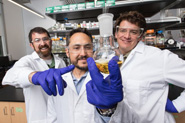
The American population is aging, and conditions such as diabetes and cardiovascular disease are on the rise. With those factors in place, the medical community has growing concerns about wound treatment. According to the American Professional Wound Care Association, about 15 percent of Medicare recipients suffer chronic, nonhealing wounds with an annual cost of about $30 billion.
One challenge physicians repeatedly face in treating wounds is the threat of bacterial infection. Closing the wound helps reduce the risk, but if pathogens infect the compromised tissue, they can readily form biofilms, hardy communities of cells covered by a protective biopolymeric layer. This layer is difficult for conventional antibiotics to penetrate, and as a consequence, biofilm-mediated infections require long treatment regimens. Microbial biofilms can result in chronic infection and often cause havoc in hospitals, where they can spread.